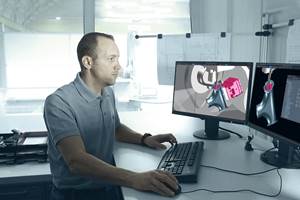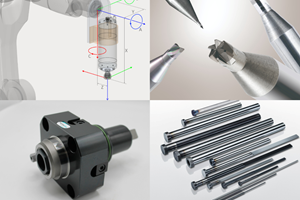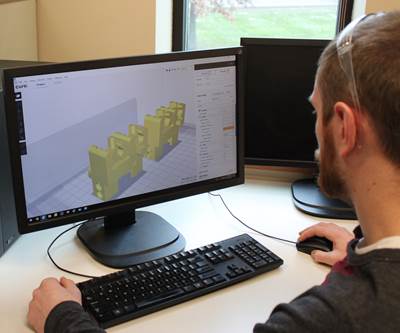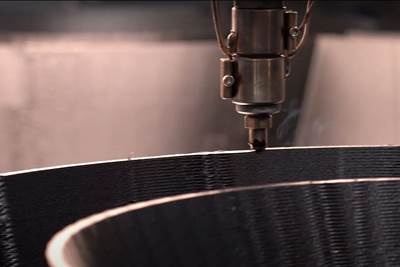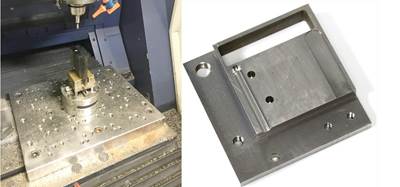3D Printed Manufacturing Aids Improve Molding Efficiency
Moldmakers and molders turn to 3D printing for end-of-arm tools, fixtures for increased safety and functionality, lower cost and faster turnaround times.
The design freedom of polymer/composite additive manufacturing (AM) makes it easy to design different front-facing/insert holding (middle left and right) and rear-facing/handle versions (right) of the claw manual end-of-arm tooling (EOAT) that Zero Tolerance LLC has produced for its own and customer molding operations. (Middle left shows an unloaded EOAT waiting for inserts and middle right shows inserts preloaded.) Not only did 3D printing a manual EOAT greatly reduce cost versus using a robot, but it increased operator safety and shortened the effective molding cycle time versus loading inserts by hand into the hot mold cavity (left showing operator using the claw to rapidly load inserts). Source | Zero Tolerance LLC
Just as additive manufacturing (AM) is increasingly producing mold components and even molds for plastic and composite parts, another growing use of both metal and plastic/composite additive technologies is to print end-of-arm tooling (EOAT)/end effectors to help molders load materials into tools and remove formed parts from them faster and more efficiently, as well as fixturing parts as they cool or undergo secondary operations. In fact, this growth area has spawned specialist suppliers that design and print EOAT and fixtures and automation companies that largely use AM to produce portions of the equipment they build to automate molding cells. Many different AM technologies are used, and the purposes to which the printed parts are put cover a broad spectrum. Following are some companies doing interesting work in this area.
Case Study 1: Zero Tolerance
Zero Tolerance LLC is a toolmaker specializing in the production of high-complexity, tight-tolerance, small-to-medium size injection molds for the medical device, automotive and defense industries. The company also custom injection molds parts ranging from olefins to high-temperature polyamides (PA) for customers in the oil/gas, prototyping and consumer goods markets.
Taking advantage of grants available from the state of Michigan during the pandemic, Zero Tolerance’s team acquired an X-7 industrial-grade continuous carbon fiber composite printer from Markforged Inc. and since then has added two additional Markforged models: an Onyx One discontinuous carbon fiber printer and a Mark Two continuous carbon fiber printer. Initially, Zero Tolerance used its printers to produce prototypes and proof of concepts for customers in continuous and discontinuous carbon fiber-reinforced polyamide (PA) and neat polylactic acid (PLA). The team also participated in a distributed manufacturing program called Project Diamond, where participants in multiple locations simultaneously printed the same parts, including protective medical equipment during the pandemic, and later, tourniquets for the war in Ukraine.
“Additive manufacturing is just another tool in your moldmaking toolbox. It’s not going to do everything, but on the other hand, it’s not going to take away anything from what you’re already doing.”
A newer use Zero Tolerance has found for its printers is to produce manual (human- not robot-operated) EOAT. The work started with a molding job the company was running for a customer that involved hand-loading eight 76-millimeter-long brass inserts into a 275°F/135°C tool prior to overmolding. Given the tool temperature (and burn risk for the operator), plus the amount of time it took to hand load each insert between molding cycles (which could extend effective cycle time significantly), co-founder/co-owner Steve Michon says Zero Tolerance initially priced out a robot. However, this wasn’t a high-volume molding job that could cost-justify that investment, so he and his team went to work and designed, printed and tested a carbon fiber-reinforced polyphthalamide device they call the “claw.”
As the current molding cycle begins, the technician monitoring the press manually slides eight inserts onto fingers on the EOAT. Once the cycle ends, the mold opens and the last set of parts are demolded, the operator positions the hand-held claw against the cavity side of the tool and, using two guide pins that act as locators to ensure proper positioning, pulls a handle, which strips the inserts off the fingers and slides them into position inside the mold. The operator then removes the claw and closes the press, and the next cycle commences as the operator loads another eight inserts into the EOAT.
“For an application like this, proper alignment was critical, so it took us a few iterations — with small design changes in critical areas of the claw — to make sure everything lined up properly,” Michon explains. The claw does its job beautifully, increasing operator safety, reducing CAPEX by more than 90% versus a robot and boosting molding throughput by 50%. To date, this EOAT has been used for more than 125,000 molding cycles (producing over 1 million overmolded parts) and only shows minor wear. Since the claw is designed and printed in 15 different pieces, if components wear or break, or a different size finger or a different number of inserts are needed, it’s easy to print and replace select components.
“Interestingly, one of our mold customers saw the claw in action in the molding area of our shop and wanted us to design something similar for their molding operations,” Michon adds. “We’ve also printed EOAT to hold parts during pad printing as well as fixtures to hold precision molded parts during CMM [coordinate measurement machine] inspections.”
Yet another way Zero Tolerance uses its printers is to produce “dummy” inserts to load into the claw when restarting the press. “Instead of wasting precision-lathed or Swiss-turned brass inserts when we restart our press to run another order of parts, we load printed dummy inserts into the claw and then into the mold, which doesn’t know the difference,” he adds. “This way, we’re throwing out inexpensive material, not costly inserts, until we get our molding process stabilized to run for the day.”
Why does Zero Tolerance keep using polymer/composite AM for these types of applications when they have a well-equipped tool shop and can easily machine metal parts? “First, you essentially add capacity in one area of your shop without having to interrupt work in another area just to create a part for an experiment or a proof of concept, and you can produce that part much quicker at a lower cost than machining metals,” Michon continues. “Design time is shorter, so you can iterate much faster to prove an idea. With the high-strength carbon fiber-reinforced parts we produce on our Markforged printers, we can achieve our objectives in a much lighter design. That way, even if we were to use a robot to operate the tool instead of a human hand, we could use a smaller robot and it would experience less wear thanks to the EOAT’s lower weight. The key is not to be closed-minded and don’t assume something won’t work until you try it out. Additive manufacturing is just another tool in your moldmaking toolbox. It’s not going to do everything, but on the other hand, it’s not going to take away anything from what you’re already doing.”
Case Study 2: Westec Plastics
Custom injection molder Westec Plastics Corp. operates 23 injection presses (some of which are shown at top) and uses additively manufactured EOAT and fixtures produced on its own in-house printer or those of local service bureaus. Shown on the bottom is an EOAT that pulls molded parts for the consumer segment from a four-cavity injection tool and clips off the runners. Source | Westec Plastics Corp.
Westec Plastics Corp. is a 54-year-old custom molder that operates 23 injection presses ranging in size from 28 to 610 U.S. tons/25 to 553 metric tons. Specializing in molding high-temperature engineering thermoplastics for the medical device market in ISO Class 6, 7 and 8 cleanrooms, Westec also serves customers in the consumer and government segments.
The company builds some of the molds it uses and outsources the rest to local toolmakers. As such, it has been specifying metal AM technology for the last few years for mold inserts with conformal cooling features that toolmakers and local service bureaus produced. Westec recently took possession of the first production metal AM printer from Mantle Inc., so it will now be able to design and print conformally cooled mold inserts in-house.
Additionally, the company has used polymer AM technology for the past 7 years — the last 4 in-house with an Ender 5 Plus fused filament fabrication (FFF) printer from Shenzhen Creality 3D Technology Co. Ltd. Initially, polymer AM was used to prototype parts. Later, use was expanded to produce part fixtures.
“Although we do try to use off-the-shelf automation components whenever possible, having the ability to design a fixture in-house and either print it ourselves or have it printed nearby is a big advantage to us.”
“We work with a lot of medical customers and they frequently modify designs, so it’s really nice to be able to print sample parts and have something physical to hold, as everything looks doable when it’s on the [computer] screen,” explains Cory Vohs, Westec director of molding. “As we gained experience, we slowly used our printer to try other things, including printing PLA fixtures to hold molded parts for pad printing. Additively manufacturing these parts is certainly faster and less costly than keeping our CNCs running.” Vohs adds that simple and smaller fixtures are printed in-house, but external resources produce larger and more complex ones. The company also uses EOAT in conjunction with cobots to help molding technicians quickly and safely demold parts.
“Although we do try to use off-the-shelf automation components whenever possible, having the ability to design a fixture in-house and either print it ourselves or have it printed nearby is a big advantage to us,” adds Travis Meeks, Westec vice president of tooling. “This way, we don’t have to interrupt our tool shop, and we can get the component much faster and at a lower cost than if we had to wait weeks to have an outside tool shop produce it conventionally. Plus, a polymer additive fixture isn’t going to damage our molded parts.”
Case Study 3: Linear AMS
Linear AMS, now part of Shapeways Holdings Inc., is a 20-year-old moldmaker turned supplier of metal additive mold components, a custom metal additive components supplier and a custom injection molder serving customers in the automotive, ground transportation, consumer/appliance, industrial, medical, oil/gas, packaging and space/defense markets. Initially, Linear’s metal AM focus was on designing and printing conformally cooled/heated mold components like slides, lifters and inserts for its injection molds, and later, those of molding and mold building customers. It added polymer AM capabilities for part prototyping. Subsequently, Linear began printing gages, fixtures and assembly aids for its manufacturing operations, including injection molding, and later for customer needs.
This inspection assembly fixture — a hybrid of metal and polymer additive technologies — features 3D-printed maraging steel (top bronze components with bolts produced via direct metal laser sintering/solidification, or DMLS) and PA12 (lower gray component produced via MultiJet Fusion (MJF) or selective laser sintering (SLS)). Use of both additive technologies helps Linear AMS reduce mass, cost and print time while producing a usable assembly aid much faster than conventionally machined metal would allow. Source | Linear AMS, a Shapeways Co.
On the metal AM side, the Livonia site has two direct metal laser sintering/solidification (DMLS) printers from EOS GmbH — one that solely prints maraging steel and one that solely prints Inconel (718) — plus an electron beam melting printer from GE Additive that solely prints titanium, and two metal binder jet printers from Desktop Metal Inc. on which are printed 17-4PH and 316-L stainless steel alloys. On the polymer AM side, there are three MultiJet Fusion (MJF) printers from HP Inc. and six selective laser sintering (SLS) printers from EOS. Typical polymer AM materials used include PA11, PA12, polypropylene, thermoplastic elastomer and thermoplastic polyurethane. Other services offered by the company include material jetting, binder jetting, stereolithography and wax casting, as well as conventional subtractive manufacturing.
“Most of our EOAT and fixtures combine both metal and polymer AM components for structural integrity, to address wear items, and to seat assembly fixtures,” explains David Myers, Linear AMS senior business development executive. “In fact, we’re currently finishing off an inspection assembly fixture that uses a combination of PA12 and maraging steel, as these items can get abused. This enables us to provide a turnkey solution for our customer.”
Interestingly, it’s not moldmaking customers who request Linear’s AM molding aids but rather molders themselves.
Typical tools the team is printing include press-based robotics for part removal or insertion of hardware into a tool prior to molding, as well as hybrid gages and fixtures. “There are times when you’ve tried everything you can from a processing and tooling standpoint and you still have warpage,” Myers continues. “In cases like that, we use our AM technology and knowledge of thermoplastic materials, injection molding and Kentucky windage to design cooling fixtures that counteract warpage and deliver dimensionally accurate parts.” He adds that initially, it was design flexibility and speed of production that encouraged the team to try producing manufacturing aids additively. “The first time we tried this, not everything worked perfectly out of the gate, but the beauty of digitization is how fast you can fine-tune a design and how quickly you can build a digital catalog that can be used to tweak future designs,” Myers says. “In fact, we’ll often design a print build to include two different design revisions at the same time since we have the real estate in the build chambers to add more parts and this makes finalizing the design quicker and easier. There are so many advantages to getting to market faster.”
Taking advantage of additive manufacturing’s ability to produce lattice structures, which not only reduce mass, material usage and cost and speed printing time, but also increase structural integrity, Linear AMS applies the technique to 3D print inspection fixtures like those shown above. The gray lattice material is PA12 produced on an MJF or SLS printer; the red handles/clamps and bolts are off-the-shelf purchased components; and the silver base plate is conventionally machined aluminum. Source | Linear AMS, a Shapeways Co.
Interestingly, it’s not moldmaking customers who request Linear’s AM molding aids but rather molders themselves. “Typically, moldmakers aren’t as concerned with downstream processes, but it’s the molders who reap the benefits,” Myers notes. “Often, because they purchased a mold with conformal cooling, now they can cycle parts much faster, which means that the downstream process isn’t keeping up with the upstream portion, so suddenly molders are asking how they can do this task or that faster. We work with them to define the scope of the process, then design manufacturing aids to address that functionality.”
What benefits do AM technologies bring? “There are the obvious things like design flexibility, speed, no scrap and lower cost,” Myers adds. “However, there’s also the ability to print lattice structures that not only are lighter and faster to print but also improve structural integrity. Also, what we’ve seen, especially on the metals side, is that AM manufacturing aids will go head-to-head with conventionally produced parts in terms of life expectancy and damage tolerance. You get all that and don’t have to wait 6 weeks to have a component produced conventionally — that’s a win-win.”
Related Content
How to Automate Process and Design
Moldmakers can improve their operations and stop wasting time by taking these six steps for process and design automation.
Read MoreDynamic Tool Corporation – Creating the Team to Move Moldmaking Into the Future
For 40+ years, Dynamic Tool Corp. has offered precision tooling, emphasizing education, mentoring and innovation. The company is committed to excellence, integrity, safety and customer service, as well as inspiring growth and quality in manufacturing.
Read MoreFive-Axis Graphite Mill With Automation Debottlenecks Electrode Machining
Five-axis electrode cutting enabled Preferred Tool to EDM complex internal screw geometry on an insert that otherwise would have had to be outsourced.
Read MoreTechnology Roundup: New/Improved Technologies You Don't Want to Miss
With all the technology joining the market, moldmaking is a versatile, ever-evolving industry. As such, this technology roundup has no specific theme — it features a variety of products for applications and solutions across the industry.
Read MoreRead Next
Putting 3D Printing to Work
Micro Mold and Plastikos together have invested more than $400,000 in technologies and processes related to 3D printing and reverse engineering over the last three years.
Read MoreHow to Prepare for the Rise of AM in Moldmaking
Mold builders should consider investing in three key areas to take advantage of the opportunities 3D printing presents.
Read MoreWestminster Tool Run Rigorous DOE on New 3D-Printed Tool Steels
Hybrid 3D printing platform offers mold builders high-tolerance metal parts faster, at lower cost and with less secondary finishing.
Read More
.jpg;width=70;height=70;mode=crop)



















